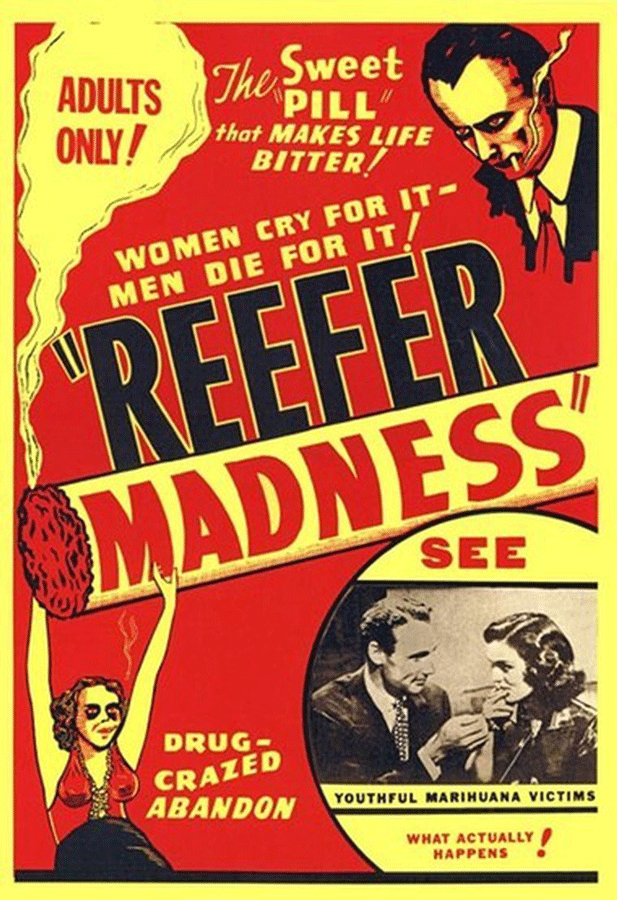The weed with the roots in hell
In the modern era, it’s hard to believe that a film such as “Reefer Madness” (1936) was once presented as factual. The movie is clearly dated – the archaic spelling of “marihuana” is used, and the drug is described as “a violent narcotic” with a plethora of dangerous symptoms.
This being said, its agedness and inaccuracy are precisely the reasons that “Reefer Madness” is worth the watch with a group of friends. An ironic testament to society’s progress, the misinformed acting and writing are fun to pick apart, and the symptoms, statistics, and statements are hilariously incorrect.
The movie cites marijuana as being more addictive, lethal, and prolific than cocaine or heroin. At the very least, the creators were right that it was more common. “Incurable insanity” and “dangerous hallucinations” are among the most noticeably fabricated effects of using the drug.
The classic stoner giggle is exaggerated as “sudden, violent, uncontrollable laughter,” along with “the total inability to direct thoughts.” Of course, there are a few effects that, though hyperbolized, are accurate – including “fixed ideas” and a sensation that “time slows down.”
All these symptoms and more are listed during a foreword that scrolls up the screen backed by swelling, somber music.
The same information is then relayed to the viewers by the character Dr. Alfred Carroll (Josef Forte) in a cheesy effort to pad time – the film is barely over an hour long, and the plot doesn’t actually kick off for seven and a half minutes.
Carrol addresses a Parent Teacher Association meeting at the beginning and end of the film, ham-handedly bookending the actual plot. In Carrol’s opening monologue, he describes typical stash spots of the addicted – the heel of a shoe, a hollowed-out dictionary, or the inside of a pocket watch.
Once the exposition dump is over, the doctor begins telling a story which fades into the actual film. It centers on an apartment owned by Mae Coleman (Thelma White) – a member of a cannabis distribution ring. Over the course of the movie, several high schoolers are invited to Mae’s apartment, where they are pressured into smoking joints.
Often this pressure is supported by the implication that the teenagers believe the reefers to be regular tobacco cigarettes. Somehow not noticing the differences in appearance, odor, or taste, the teens invariably become high, and consequences escalate until the climax – a sexual assault and manslaughter.
The film was originally intended to inform parents of the dangers of marijuana – it was even titled “Tell Your Children” during production. Funded by a church group, the movie received a recut after being shot – it was sold as a moral guidance film, but also leaned heavily into the dark and risqué – at least by thirties’ standards.
A relic of the culture of that decade, the film offers an extreme interpretation of the drug. Even during its era, “Reefer Madness” was a joke – a poorly constructed argument presented by a poorly constructed movie.
Displays of inebriation are, as with much of the movie, overdone and campy. Forced, nearly maniacal laughter permeates nearly every user of the drug. In the colorized version, lime green smoke is used to denote usage of pot. Bouts of insanity are displayed frequently, though the acting is always uncomfortable and forced.
This is where most of the modern entertainment value is found in “Reefer Madness” – the quality of the product being just as poorly preserved as the film’s beliefs about cannabis.
There’s a sort of twisted humor to the film – the characters’ portrayals of stoned giggles are somehow laughably bad yet entirely relatable. It’s hard not to join in when Ralph Wiley (Dave O’Brien) begins laughing immediately after taking a single hit off a 1930’s reefer.
The cinematography feels like a high school class project. The camerawork is sloppy, with jittery stills and shaky pans plaguing the movie. Early in the film, a lead actor is clearly used as a background character. Several shots are cut partway through – and the inconsistencies are jarring and obvious.
It’s amusing to point out these moments while watching with friends. Even during its time, “Reefer Madness” was regarded as one of the worst films ever made. Compared to other films from the era, such as “The Wizard of Oz” (1939), “Gone with the Wind” (1939), and “All Quiet on the Western Front” (1930), it’s no wonder the film kept so poorly – it was never any good to begin with.
“Reefer Madness” is undeniably a poorly put together production from an era of misinformation and a frightened populace. It never achieved its purpose of preventing the outbreak of cannabis – it did so poorly that when the seventies rolled around, the movie saw a resurgence in popularity as a satire of itself.
Now in the public domain, it’s been uploaded to YouTube several times. Much like in the seventies, the push for cannabis reform has ignited an ironic love for the film. As such, if a horribly outdated movie is ever in need, “Reefer Madness” is a wonderful choice.

Senior, Creative Writing
From Fletcher, VT
Spring 2020-Present
"Call me mommy and I'll bring you blankets and hold you while you cry."






